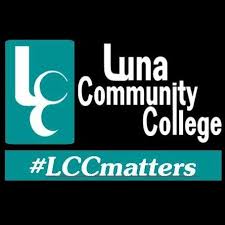Jesse Gallegos
Public Relations Coordinator
Luna Community College
Sept. 15, 2021
Project explores how state’s nursing programs have overcome COVID challenges
By Dave Kavanaugh
Luna Community College
Being forced to operate amid the upheaval created by COVID-19 led to some innovative solutions and new directions for nursing faculty across New Mexico.
Such experiences and insights were shared in “Nursing Education: From Classroom To Computers,” an article co-authored by Susan Grohman, a nursing instructor at Luna Community College.
The article, a research project initiated by the New Mexico Nursing Education Consortium (NMNEC), was published in the Journal of Professional Nursing and ScienceDirect, nationally read and recognized scholarly publications. Grohman’s co-authors included Judy Liesveld and Mary Wright of the University of New Mexico, Kimberly Petrovic of Western New Mexico University, and Teresa Leon of New Mexico State University.
“When the pandemic hit, there was a lot of stress we heard from the students, and a lot of stress from the faculty,” Grohman recalled. “We met to begin to problem-solve.”
When the COVID pandemic struck the U.S in the middle of the Spring 2020 semester, schools across the country were forced to close campuses and move operations online. That in turn forced faculty to learn new ways to adapt and continue teaching. As documented in the article, instructors developed web-based teaching resources, computer-based clinical checklists, computer-based simulations and other methods.
Grohman acknowledged that many faculty members had to learn how to teach online — and how to teach online almost exclusively — which presented a challenge.
“A lot of schools purchased virtual simulation (software), including Luna. The students would use the online simulators. Then we would get together and debrief … Instructors who were teaching skills would record themselves, and students would view the recordings. Class and mentor meetings were online. We’d break up students into groups and then come back to Blackboard to gather. You can still almost replicate the classroom really closely.”
Another curveball was providing clinical training to student nurses while most hospitals and other facilities were restricting access due to COVID. While working with those facilities to gain whatever access was available, schools provided clinical hours in a virtual setting, and the state Board of Nursing made allowances for up to 70 percent of the clinical requirement to be completed virtually, Grohman noted. Many hospitals hiring new grads incorporated longer orientation periods.
One unforeseen benefit that came from the pandemic was the opportunity for student nurses to gain practical clinical experience from helping with the state Department of Health’s vaccination clinics and COVID testing. Luna nursing students found themselves playing a vital role in fighting the pandemic and helping society on a broader scale than would have been otherwise possible.
“The whole pandemic is such a learning experience,” Grohman said. “Students don’t realize how flexible they have to be as nurses. But (abrupt changes to conditions and demands) happens in the real world. It’s made them realize life is not just black and white. You have to be flexible. You have to be able to change at a moment’s notice. It’s true for faculty too. We all have to be flexible.”
And resourceful — as in borrowing a facility or parking lot with reliable WiFi to connect for a class or assignment, in case home lacks that connectivity. And persistent — as in scheduling virtual office hours as needed for meetings between faculty and students.
“Now that the students are able to get back out into the community (i.e. for clinical rotations), it’s going to be very rewarding for them. They’re going to have to be aware of using masks and washing hands and meeting requirements. You wear personal protective equipment with a MRSA patient; now you wear it with other patients as well. But the students are excited to get back out there.”
An additional finding from the project is that nursing instructors and program directors have increasingly learned the value of collaboration with peers to share resources and ideas.
Representatives of the state’s nursing programs and members of NMNEC “mobilized quickly to collaborate, share resources, and problem-solve complex issues facing their nursing programs,” the article noted. “Rich information and outcomes resulted from the weekly remote meetings.”
NMNEC’s foresight and quick response — initiating the projects as early as April 2020, amid the wave of shutdowns — aimed to provide practical solutions that could be shared across the state. The resultant research and insights were quickly published as well, so they could benefit others beyond New Mexico’s nursing programs.
“There’s all kinds of implications where things can be used,” Grohman said. “It’s changed a lot of the way nursing education is approached. Now that we have the ability to go online, there’s no more snow days! We have other resources to get them out of the classroom to where we need to be.”
And while the jury’s still out on how well the adjustments and adaptations have worked, especially for the cohort of students whose primary training took place during the shutdown, the initial students have been able to pass their board exams.
Grohman first came to Luna in 2011-13 and has been working as part of the nursing faculty since 2015. She’s working on her PhD and found value in collaborating with nursing educators who have already attained doctorates and who’ve published research before. This project, she said, has opened her mind to other research possibilities, which in turn has informed her work in the classroom.
“It’s done a lot for me,” she said. “In class I often start by saying, ‘Research shows …’ In nursing we deal in evidence-based practices, so this (just takes it further).”
The published research of which Grohman was a contributor is bearing fruit as a resource used across the country. Lucia Gomez-Vaughan, a fellow nursing instructor at Luna, referenced the article as she completed work on her master’s degree.
Research may be invigorating for Grohman, but she said she continues to be motivated by the opportunity to help students grow and develop.
“I like teaching them,” she said, “and seeing them go from where they don’t know what they’re doing to where the light bulb comes on … to where they’re passing the boards and the NCLEX (the national nursing licensure exam).”
“And we have a good nursing faculty here and a lot of support.”
###

Luna nursing faculty member Susan Grohman instructs students at the college’s simulation lab. (file photo)




